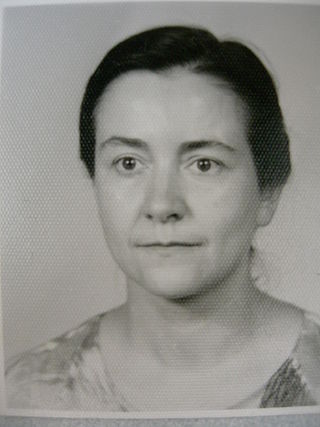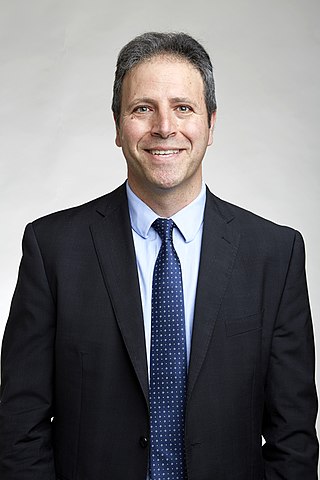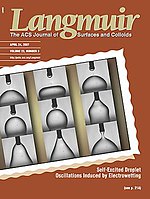
A colloid is a mixture in which one substance consisting of microscopically dispersed insoluble particles is suspended throughout another substance. Some definitions specify that the particles must be dispersed in a liquid, while others extend the definition to include substances like aerosols and gels. The term colloidal suspension refers unambiguously to the overall mixture. A colloid has a dispersed phase and a continuous phase. The dispersed phase particles have a diameter of approximately 1 nanometre to 1 micrometre.

Irving Langmuir was an American chemist, physicist, and engineer. He was awarded the Nobel Prize in Chemistry in 1932 for his work in surface chemistry.

Physical chemistry is the study of macroscopic and microscopic phenomena in chemical systems in terms of the principles, practices, and concepts of physics such as motion, energy, force, time, thermodynamics, quantum chemistry, statistical mechanics, analytical dynamics and chemical equilibria.

Surface science is the study of physical and chemical phenomena that occur at the interface of two phases, including solid–liquid interfaces, solid–gas interfaces, solid–vacuum interfaces, and liquid–gas interfaces. It includes the fields of surface chemistry and surface physics. Some related practical applications are classed as surface engineering. The science encompasses concepts such as heterogeneous catalysis, semiconductor device fabrication, fuel cells, self-assembled monolayers, and adhesives. Surface science is closely related to interface and colloid science. Interfacial chemistry and physics are common subjects for both. The methods are different. In addition, interface and colloid science studies macroscopic phenomena that occur in heterogeneous systems due to peculiarities of interfaces.

Agnes Luise Wilhelmine Pockels was a German chemist whose research was fundamental in establishing the modern discipline known as surface science, which describes the properties of liquid and solid surfaces and interfaces.

Advanced Functional Materials is a peer-reviewed scientific journal, published by Wiley-VCH. Established in February 2001, the journal began to publish monthly in 2002 and moved to 18/year in 2006, biweekly in 2008, and weekly in 2013.
Inverse gas chromatography is a physical characterization analytical technique that is used in the analysis of the surfaces of solids.
Arthur Wilson Adamson was an American chemist who is considered a pioneer in inorganic photochemistry. His research made significant contributions to the understanding of physical adsorption and contact angle phenomena, and the thermodynamics of surfaces and irreversible adsorption.

Evaporation suppressing monolayers are materials that when applied to the air/water interface, will spread and form a thin film across the surface of the water. The purpose of these materials is to reduce evaporative water loss from dams and reservoirs.

The Journal of Colloid and Interface Science is a peer-reviewed scientific journal published by Elsevier. It covers research related to colloid and interface science with a particular focus on colloidal materials and nanomaterials; surfactants and soft matter; adsorption, catalysis and electrochemistry; interfacial processes, capillarity and wetting; biomaterials and nanomedicine; and novel phenomena and techniques. The editor-in-chief is Martin Malmsten. The journal was established in 1946 as Journal of Colloid Science. It obtained its current name in 1966.

Milliana Kroumova Kaisheva was a Bulgarian physical chemist, internationally known for her work in electrochemistry and colloid chemistry.
Dispersion Technology Inc is a scientific instrument manufacturer located in Bedford Hills, New York. It was founded in 1996 by Philip Goetz and Dr. Andrei Dukhin. The company develops and sells analytical instruments intended for characterizing concentrated dispersions and emulsions, complying with the International Standards for acoustic particle sizing ISO 20998 and electroacoustic zeta potential measurement ISO 13099.
Ponisseril Somasundaran is an American mineral engineer of Indian origin and a LaVon Duddleson Krumb Professor of Mineral Engineering at Columbia University, New York.

Hai-Lung Dai is a Taiwanese-born American physical chemist and university administrator. He currently is the Laura H. Carnell Professor of Chemistry and Vice President for International Affairs at Temple University in Philadelphia, Pennsylvania, in the United States.

Nidal Hilal DSc PhD EurIng CEng FIChemE FLSW FRSC is an academic, engineering scientist and scientific adviser. He is a Global Network Professor at New York University and the Founding Director and Principal Investigator of NYUAD Water Research Center. He held professorships at the University of Nottingham and Swansea University in the United Kingdom. He is an Emeritus Professor of Engineering at Swansea University and the Founding Director of the Centre for Water Advanced Technologies and Environmental Research (CWATER).

Orlin D. Velev is the INVISTA Professor in the Department of Chemical and Biomolecular Engineering at North Carolina State University. He is best known for his work in soft matter, colloid science, and nanoscience.

Irshad Hussain is a Pakistani Scientist in the field of chemistry and among the few pioneers to initiate nanomaterials research in Pakistan.

Jean-Louis Salager was born in Montpellier, France, on May 22, 1944. He obtained the titles of BSc. in chemistry (1966) and chemical engineering (1967) at the University of Nancy (France), MSc. in chemical engineering (1970) and PhD in chemical engineering (1975) at the University of Texas and postdoctorate at the University of Texas (1977–1978). Admitted as assistant professor at the School of Chemical Engineering Universidad de Los Andes, Mérida, Venezuela (1970), where he recently obtained the professor emeritus category. He has supervised over 100 undergraduate and 60 MSc & Dr/PhD dissertations. He has written 20 book chapters and more than 600 articles and communications. He is the second most cited researcher in Venezuelan institutions, according to the Google Scholar Scitations ranking published in 2015.

Francesco Caruso is Melbourne Laureate Professor and National Health and Medical Research Council (NHMRC) Senior Principal Research Fellow in the School of Chemical and Biomolecular Engineering at the University of Melbourne, Australia. Caruso is deputy director of the Australian Research Council (ARC) Centre of Excellence in Convergent Bio-Nanoscience and Technology.














